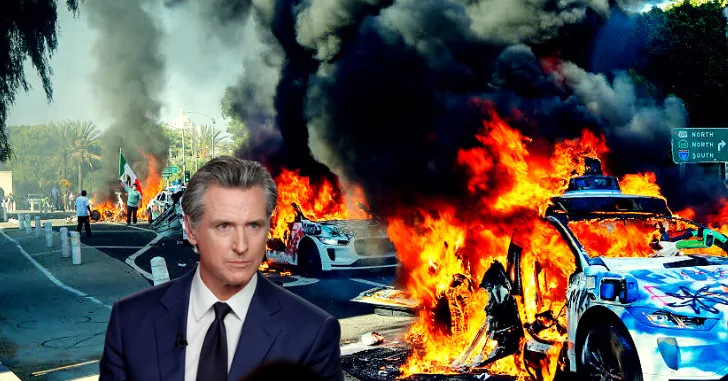In a dramatic escalation of civil unrest, protesters in Los Angeles and San Francisco have turned their anger toward an unexpected target: driverless electric vehicles operated by Waymo, a subsidiary of Google parent company Alphabet. Over the past several days, multiple Waymo EVs have been vandalized, torched, and graffitied as part of wider demonstrations against federal immigration enforcement and other government policies.
The incidents raise serious questions about the safety, scalability, and public acceptance of autonomous vehicles, particularly in politically charged environments. As cities struggle to balance innovation with social tension, Waymo’s robotaxis have found themselves in the crosshairs of a new wave of unrest.
Waymo Robotaxis Set on Fire in Los Angeles
On a tense weekend in downtown Los Angeles, multiple Waymo self-driving electric vehicles were spray-painted with protest slogans and set ablaze. Protesters, who gathered in opposition to recent Immigration and Customs Enforcement (ICE) roundups of undocumented migrants, appeared to use the highly recognizable autonomous vehicles as symbolic targets to express broader anti-establishment anger.
Eyewitness videos and photos posted to social media showed Jaguar I-PACE EVs—Waymo’s current driverless model—burning intensely. Unlike traditional car fires, these EV blazes were especially difficult to extinguish due to the lithium-ion batteries. Fire experts have long warned that EV battery fires burn hotter, can reignite even after appearing to be out, and release hazardous fumes.
According to Fire Marshal Andy King of Franklin, Tennessee, “the surest approach is to stand back and ‘let it burn,’” when EVs catch fire—a strategy he described to The Wall Street Journal in 2023. This makes EVs a uniquely dangerous element during urban unrest, both for emergency responders and nearby civilians.
Waymo Restricts Service in LA and San Francisco
In response to the violent protests, Waymo announced it was suspending its autonomous ride-hailing service to parts of downtown Los Angeles. While the company emphasized that the fleet is still operating in other parts of the city, user data from the Waymo app indicates broader limitations. For example, no rides were available Monday morning between West Los Angeles and destinations such as Crypto.com Arena or the University of Southern California—locations well outside the main protest zones.
The restrictions weren’t limited to Los Angeles. In San Francisco, Waymo quietly limited pickup and drop-off access in neighborhoods such as the Mission District, SoMa (South of Market), and the downtown core—areas where demonstrations were anticipated. Users reported longer-than-usual wait times and elevated fare estimates, signaling system strain and safety prioritization.
A Waymo spokesperson confirmed that the company is working closely with local law enforcement and emphasized that the vehicles destroyed in LA were not summoned by customers on the scene. An internal investigation into how the vehicles ended up in high-risk areas is underway.
Why Protesters Are Targeting Driverless Vehicles
At first glance, targeting autonomous vehicles might seem disconnected from immigration protests. But to many demonstrators, Waymo’s robotaxis represent more than just a novel technology—they are a proxy for the surveillance state, economic displacement, and what some perceive as the unchecked power of Silicon Valley.
“Waymo cars are visible symbols of corporate overreach,” said one protester in a statement shared anonymously through local activist groups. “They drive around our cities without our consent, gathering data, replacing jobs, and now they’re silent as ICE tears families apart.”
The protest strategy also capitalizes on the vulnerabilities of autonomous systems. Unlike human-driven vehicles, Waymo cars can be targeted without immediate personal risk to a driver. They can be spray-painted, obstructed with traffic cones, or even set on fire without the potential of harming a person—making them prime candidates for theatrical protest.
EV Fire Hazards: A Growing Safety Risk in Civil Unrest
While car fires are not new during periods of civil disorder, the nature of electric vehicle combustion presents new dangers. EVs are powered by high-capacity lithium-ion batteries, which contain flammable materials and can release oxygen as they burn. This makes extinguishing the fire much more difficult than with traditional gasoline-powered vehicles.
These battery fires can smolder internally and reignite hours or even days later, posing a continuous hazard. They also emit toxic gases, including hydrogen fluoride, which are harmful to both people and the environment.
According to the National Transportation Safety Board (NTSB), EV fires have a lower overall incidence than traditional car fires, but when they do happen, the consequences can be significantly more severe.
Ongoing Vandalism and Community Pushback
The weekend’s chaos wasn’t the first sign of hostility toward autonomous vehicles in California. Even before the latest demonstrations, Waymo vehicles had been the subject of community pushback in places like Santa Monica, where residents reportedly placed traffic cones around charging depots to block access.
Nearby residents have also complained about the vehicles making noise while reversing and honking when parked too close to one another. Though minor compared to arson, these issues indicate that resentment toward the autonomous fleet has been simmering for months.
Additionally, vandalism spread beyond Waymo. E-scooters operated by Lime were seen being thrown and damaged during the protests, suggesting a broader hostility toward shared tech-based transportation in general.
What These Attacks Mean for the Future of Driverless Mobility
The violence against Waymo’s fleet could have major implications for the future of autonomous transportation—not just in California, but across the country. As the technology matures and expands, so too do the challenges of public trust, safety, and security.
For investors, automakers, and tech developers, these events are a wake-up call. Operating autonomous fleets in dense urban environments requires more than just technical prowess—it demands deep community engagement, robust safety protocols, and contingency planning for public unrest.
Additionally, the financial toll is significant. Waymo’s self-driving Jaguars, which start at around $73,000 apiece, are equipped with lidar sensors, radar systems, multiple cameras, and high-end computing power. Some estimates put the total cost of a Waymo vehicle between $150,000 and $200,000. Damage to even a few of these cars represents a substantial operational and financial loss.
Waymo has declined to disclose how many vehicles have been damaged or how much financial impact the unrest has had on its 300-vehicle fleet in Los Angeles.
Autonomous Cars and Civil Liberties: The Debate Ahead
This situation also reignites the debate over how much data autonomous vehicles collect, and how that data may be used. Privacy advocates have long expressed concern about whether self-driving cars could be used as surveillance tools—particularly in neighborhoods already vulnerable to over-policing or immigration raids.
“These cars are rolling surveillance platforms,” said Albert Fox Cahn, executive director of the Surveillance Technology Oversight Project, in a separate interview earlier this year. “They collect vast amounts of data, often without meaningful oversight.”
For activists, the combination of high-tech visibility, government proximity, and perceived disregard for community input has made driverless vehicles like Waymo a potent symbol of systemic overreach.
The Collision Between Innovation and Social Reality
As Waymo navigates its path forward, it must reckon with the realities of deploying high-profile autonomous technology in cities grappling with social tension and political unrest. What happened in Los Angeles and San Francisco is unlikely to remain isolated. Other tech companies in the mobility space—including Cruise, Tesla, and Uber—should take note.
Driverless vehicles may be the future of transportation, but recent events serve as a stark reminder: no matter how advanced the AI, success on the streets will ultimately depend on public perception, social acceptance, and the ability to adapt to unpredictable human behavior.





